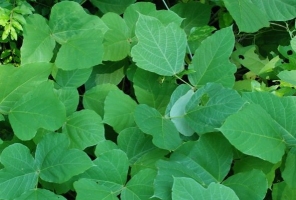Kudzu is also known as Kuzu, Chinese arrowroot or Japanese arrowroot. Its scientific name is Pueraria montana. This plant has its native origin in Southeastern China and Japan. During the Philadelphia Centennial Exposition, Kudzu found its way to the USA in the late 19th century.
Upon its arrival in the USA, it quickly became a widely cultivated ornamental plant. These perennial vines are also in Southeast Asia and a number of Pacific Islands.
During the first half of the 19th century, the USA Soil Conservation Service began to recommend kudzu as the best plant for curbing soil erosion. However, Kudzu is a fast-growing plant that has spread throughout the Northeast, Midwestern, and Southeast USA.
What Makes Kudzu Unique

Kudzu is a climbing and deciduous plant. It is known to grow by 1 foot every day. It spreads mainly by vegetative propagation and by seeds on certain rare occasions. For the Kudz seeds to germinate, the soil must be constantly wet for one week with an ambient temperature above 68 degrees Fahrenheit.
Only one or two of the Kudzu seeds might be capable of germinating in a pod of Kudzu seeds. Kudzu leaves are 5-13 cm wide, 7-25 cm long, with 2 or 3 lobes and a pointed tip. This plant has pea-like flowers with a grape-like scent and a length of 12 – 18mm. Kudzu is a resilient plant that thrives in an obscured or sunny environment once it attains maturity.
What Happens When a Vine Grows Out of Control
Due to Kudzu’s fast growth rate, it is known to grow over trees, fences, and environmental structures up to 100 feet. For this reason, Kudzu outcompetes other plants for root space, blocking sunlight from reaching them thereby killing them.
Consequently, this plant decreases biodiversity and affects the herbivorous animals that depend on certain plant species. Due to its dominant nature, kudzu can drastically change the forest structure and ecosystem.
On the positive side, this plant can be used to control soil erosion on eroded slopes. Farmers use it to feed their livestock as well. Kudzus is also known to be a nitrogen-fixing plant, thereby increasing soil fertility.
Keeping Kudzu Under Control

While Kudzu has potential positive benefits, its adverse effects can become more prominent when its population becomes too high. The most cost-effective way to reduce the large Kudzu population is via grazing.
Cattle grazing for a period of three to four years is the most effective way to eliminate Kudzu, especially during the growing season from July to September. For the best results, it is best to enclose the area with a large Kidzu population so that livestock can continually feed on them.
Herbicides with active ingredients like triclopyr and glyphosate are the perfect options for controlling Kudzu. However, it is essential to follow label instructions while applying herbicides in order to prevent damage to nearby foliage and vegetation.
Beyond these measures, it is crucial to take proactive measures to monitor Kudzu in your area before it gets too high. At the early stages of Kudzu growth in an area, you can easily pull or dig them out.
Future Challenges and Considerations
At present, Kudzu is taking over farmlands and serving as a habitat for pests like the Kudzu bug. In the USA, it is also known to grow over infrastructure like railway tracks and power lines, thereby increasing maintenance costs annually.
With the higher atmospheric Carbon dioxide, Kudzu will experience a higher growth rate and spread into new regions. Carbon dioxide increases this plant’s photosynthetic efficiency.
As Kudzu spreads, it will likely reduce biodiversity and alter soil chemistry by fixing more nitrogen in the soil. While using Kudzu to control soil erosion in the right circumstances is perfect, it is vital to implement sustainable land management practices to keep this plant in check.

